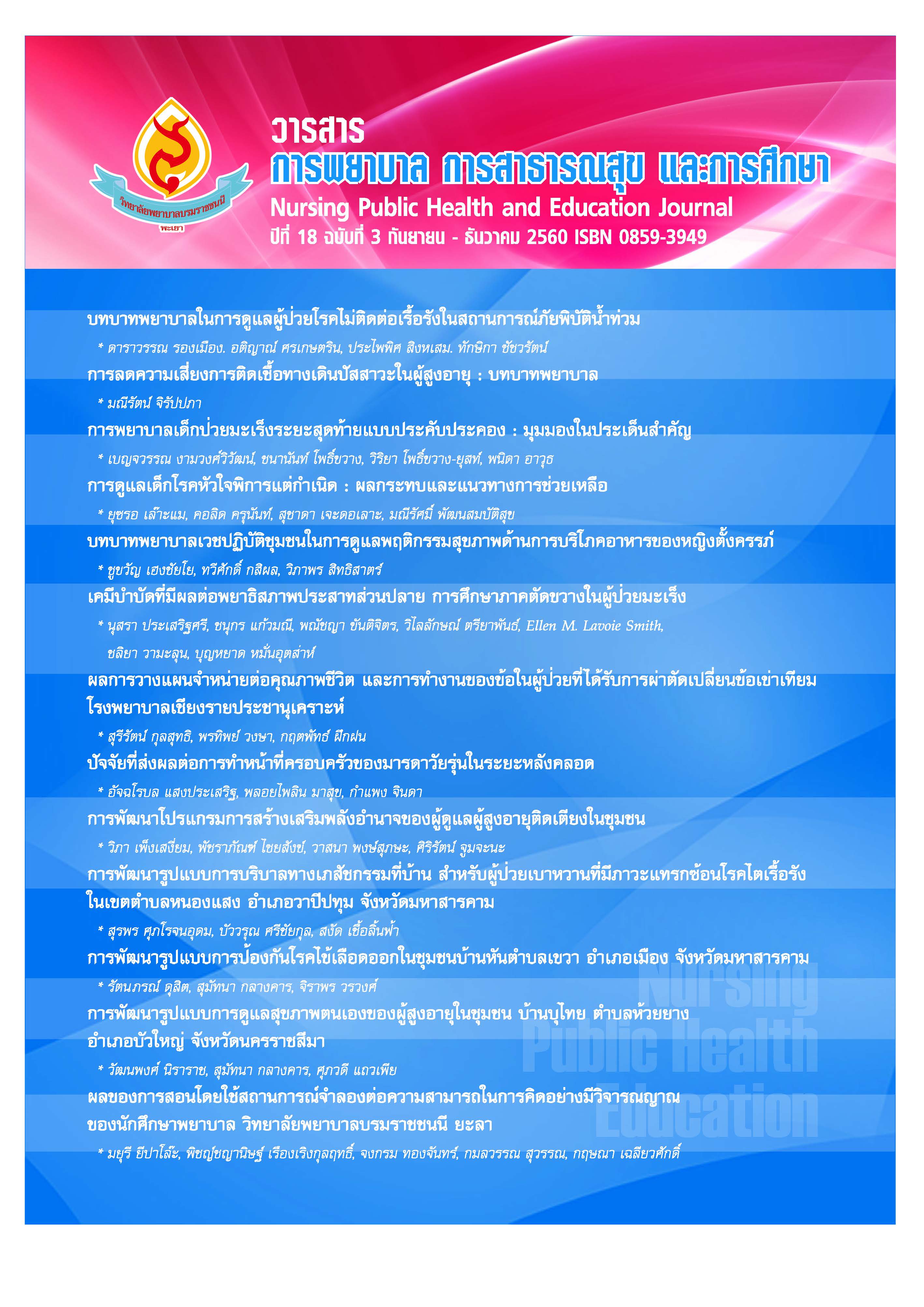การลดความเสี่ยงการติดเชื้อทางเดินปัสสาวะในผู้สูงอายุ : บทบาทพยาบาล Reducing Risk of Urinary Tract Infection in Older Persons : Nurse’s Role
คำสำคัญ:
การพยาบาล, การติดเชื้อทางเดินปัสสาวะ, ผู้สูงอายุ, Nursing, Urinary Tract Infection, Older Personsบทคัดย่อ
การติดเชื้อทางเดินปัสสาวะเป็นปัญหาทางคลินิกในผู้สูงอายุ วัตถุประสงค์ของบทความวิชาการนี้เพื่อนำเสนอและทบทวนความรู้การลดความเสี่ยงการติดเชื้อทางเดินปัสสาวะในผู้สูงอายุ ปัญหานี้เป็นภัยเงียบเนื่องจากไม่พบอาการแสดงในผู้สูงอายุทำให้ยากต่อการวินิจฉัยโรค การติดเชื้อดังกล่าวอาจพบเชื้อโรคดื้อยาปฏิชีวนะส่งผลต่อการรักษา ค่าใช้จ่ายสูง และเสียชีวิตจากการติดเชื้อในกระแสโลหิต สาเหตุส่วนใหญ่เกิดจากเชื้อแบคทีเรียเอสเชอริเชีย โคไล โดยมีปัจจัยเสี่ยงสำคัญที่ทำให้ผู้สูงอายุติดเชื้อทางเดินปัสสาวะ คือ การเพิ่มขึ้นของอายุทำให้ความเป็นกรดในปัสสาวะและภูมิคุ้มกันลดลง การสัมผัสการติดเชื้อเพิ่มขึ้นจากการใส่เครื่องมืออุปกรณ์เข้าไปในทางเดินปัสสาวะ และมีแหล่งสะสมเชื้อโรคเพิ่มขึ้นในร่างกาย เช่น เกิดโรคร่วมทำให้ปัสสาวะค้างอยู่ในกระเพาะปัสสาวะมาก โดยเฉพาะอย่างยิ่งหากผู้สูงอายุมีปัสสาวะเล็ด ดูแลกิจวัตรประจำวันไม่ได้ สมองทำงานบกพร่องรุนแรง ใช้ยาปฏิชีวนะไม่เหมาะสม ไม่สามารถเคลื่อนไหวและนอนรักษาในโรงพยาบาลจะเสี่ยงต่อการติดเชื้อทางเดินปัสสาวะเพิ่มขึ้น ดังนั้นกลยุทธ์การลดความเสี่ยงการติดเชื้อทางเดินปัสสาวะในผู้สูงอายุควรเน้นการป้องกันโรคและส่งเสริมสุขภาพ ซึ่งประกอบด้วย การลดจำนวนเชื้อโรคในทางเดินปัสสาวะ และหลีกเลี่ยงปัจจัยเสี่ยงการติดเชื้อทางเดินปัสสาวะ ด้วยวิธีการคัดกรอง ให้ความรู้ ให้คำปรึกษา จัดการ และประสานงาน โดยเฉพาะแนวทางการลดความเสี่ยงการติดเชื้อเพื่อป้องกันการติดเชื้อทางเดินปัสสาวะโดยใช้ยาและไม่ใช้ยาในผู้สูงอายุมีความสำคัญสำหรับพยาบาลในการสร้างความเข้าใจและนำไปประยุกต์ใช้ให้เหมาะสม
คำสำคัญ : การพยาบาล การติดเชื้อทางเดินปัสสาวะ ผู้สูงอายุ
Urinary tract infection (UTI) is a clinical problem of elderly. The purposes of this article are to present and review knowledge about reducing risk of urinary tract infection in older persons. This problem is a silent disaster because there is an asymptoms in the elderly, making it difficult to diagnose. This infection may be antibiotic resistance in pathogens which effect to cure with high cost including death by bacteremia. The most cause of bacterial infection is Escherichia coli. The important risk factors of UTI in the elderly are increasing age to reduce acid in urine and decrease immunity, increasing to contact infection from equipment into urinary tract and increasing source of agent in the body such as comorbid illness related to more residual urine in the bladder. Especially, higher risk of UTI in the older persons are urinary incontinence, disability in daily living, severe cognitive impairment, inappropriate use of antibiotic, immobile and hospital admission. Therefore, strategies for reducing the risk of UTI in older persons should focus on prevention and health promotion. Thus including decrease the number of pathogens in urinary tract, and avoid risk factors of urinary tract infection by method of screening, providing knowledge, counselling, managing and coordinating. Especially, the guideline prevent the reducing risk of UTI by using pharmacology and non-pharmacology in older persons that is an important for nurse to understand and apply it appropriately.
Keywords : Nursing, Urinary Tract Infection, Older Persons



